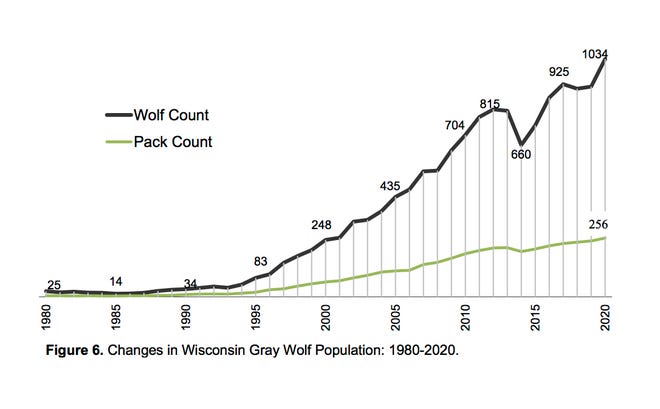Paul A. Smith Milwaukee Journal Sentinel
Not even wildlife experts saw it coming.
In fact, 50 years ago it wasn’t clear whether even a single pack could survive in Wisconsin.
But the recovery of the gray wolf in the Badger State has exceeded virtually all expectations.
If your financial holdings performed similarly over the same time period, you’d be very happy.
The Wisconsin wolf population has increased from a handful of animals in the 1970s to an estimated 1,195 animals and 256 packs last winter, according a report by the Department of Natural Resources.
Both are modern-era highs for the species in Wisconsin.
Though wolves are wild and strong, their recovery would not have happened without help from humans, first as bounties were ended and later as protections were put in place, including through the federal Endangered Species Act.

But what does the future hold? Will humans continue to help and find ways to coexist with wolves? Or will conflicts with wolves cause state and federal wildlife officials try to drive down numbers of the large predators?
Perhaps the best perspective on the future of wolves can come from someone who has seen the arc of the species’ comeback over several decades.
“It’s been quite a remarkable change, of course,” said Peter David, wildlife biologist since 1986 with the Great Lakes Indian Fish and Wildlife Commission in Odanah. “I certainly wouldn’t have predicted it.”
David, whose responsibilities include wolf stewardship for Ojibwa tribes in Wisconsin, was among the presenters Wednesday at the Great Lakes Wolf Symposium.
The annual event was held virtually this year due to the coronavirus pandemic; it was hosted by the Timber Wolf Alliance and Northland College.
In David’s time in front of the computer camera Wednesday, he argued that the increase in wolf numbers in recent decades was even more impressive than those of other native species such as trumpeter swans, sandhill cranes and wild turkeys.
“There were efforts to wipe out wolves,” David said. “Very different from those other species.”
Citing a 2014 survey in Wisconsin and a 2019 survey in Minnesota, David said if state and federal wildlife officials listen to a majority of the public, he’ll be optimistic about the future of wolves.
“A distinct majority of the general public in both of those surveys, and as many as 86% in one, wanted as many or more wolves as existed at that time,” David said.

The public generally supports wolves as a valuable member of the ecosystem and a prized, if rare, wildlife sighting in the region.
Deer hunters and farmers are two groups that have traditionally opposed higher wolf numbers.
Not all deer hunters hate wolves, of course. Many respect the predators ability to keep deer herds and forests healthier.
And technology may provide relief in coming years for livestock producers who are plagued by wolf depredations.Get the Coronavirus Watch newsletter in your inbox.
Updates on how the coronavirus is affecting your community and the nationDelivery: VariesYour Email
The last 50 years have shown how much things can change regarding wolves. Who knows what is coming down the pike?
David humbly offered up 10 predictions for the status of wolves in the Upper Midwest in the year 2040:
- A modest population of ma’iingan (wolves) is living in the Lower Peninsula of Michigan.
- The concept of social carrying capacity for any wildlife species has died a quiet death.
- None of the states in the region has an upper limit to the wolf population defined in their state stewardship plans.
- Chronic wasting disease in deer is largely held at bay in areas with healthy wolf populations.
- Somewhere, someone is suing someone over something about wolves.
- Cooperation between tribes and the states have reached a new zenith of productivity.
- Non-lethal management techniques predominate livestock depredation control efforts.
- State agencies embrace wildlife as public trust resources; non-hunters actively participate in wildlife policy decision-making; world does not end.
- Pockets of cedar regeneration are found in Great Lakes ma’iingan range.
- Deer hunters are wolf advocates; Green Bay Packers fans welcome the Chicago Bears into the newly-formed World Football League, even while maintaining that the bears still (stink).
How many do you think will come to pass? Could a majority of deer hunters ever become wolf lovers?
I know it’s hard to envision. But remember how much things have changed.
“It’s humbling to think about what we didn’t know about wolves even 20 years ago,” David said. “We need to remember how much more we still have to learn.”
The wolf symposium resumes for a Thursday morning session. Registration is required; visit northland.edu and search “wolf symposium” for more information.
